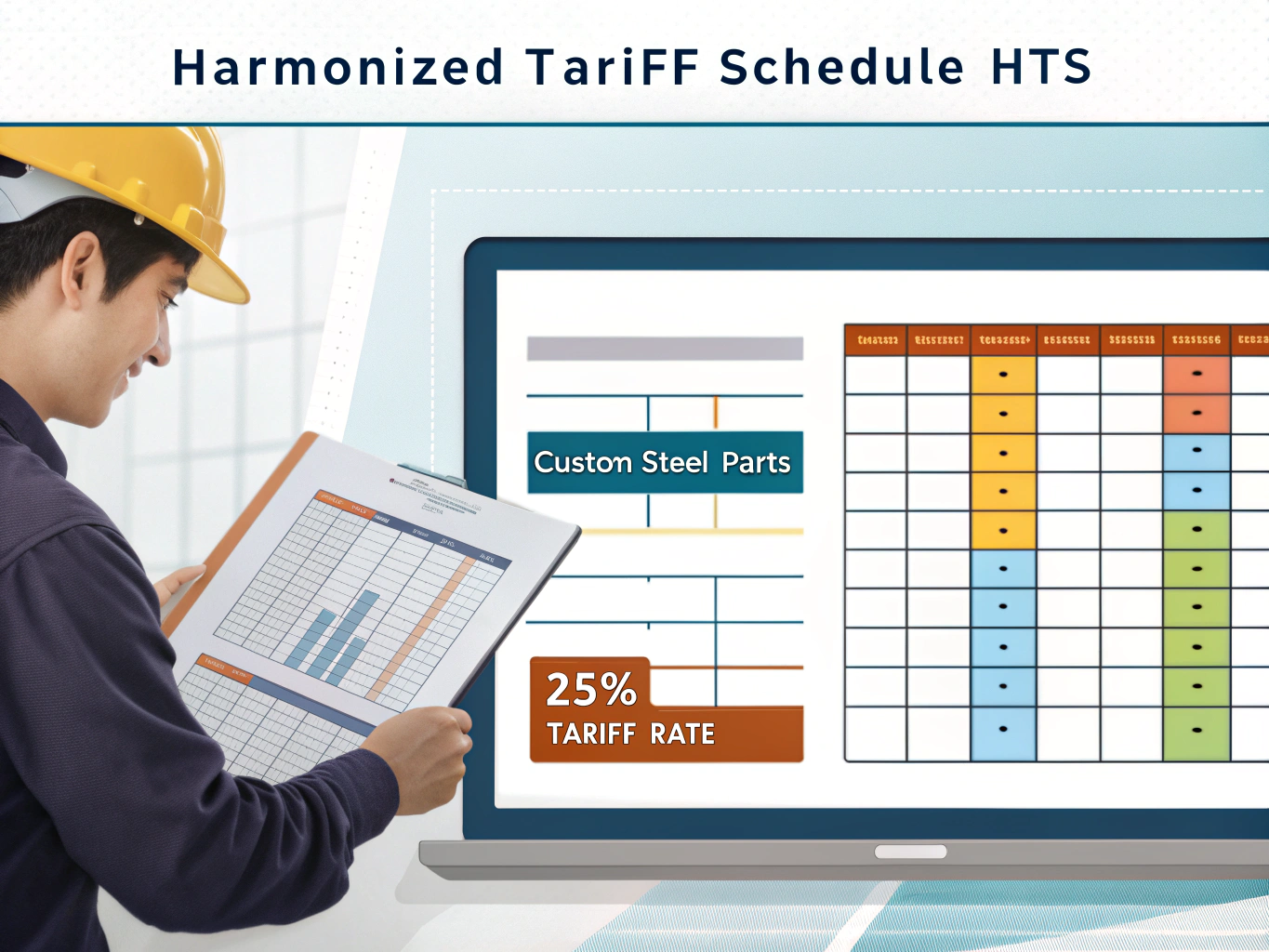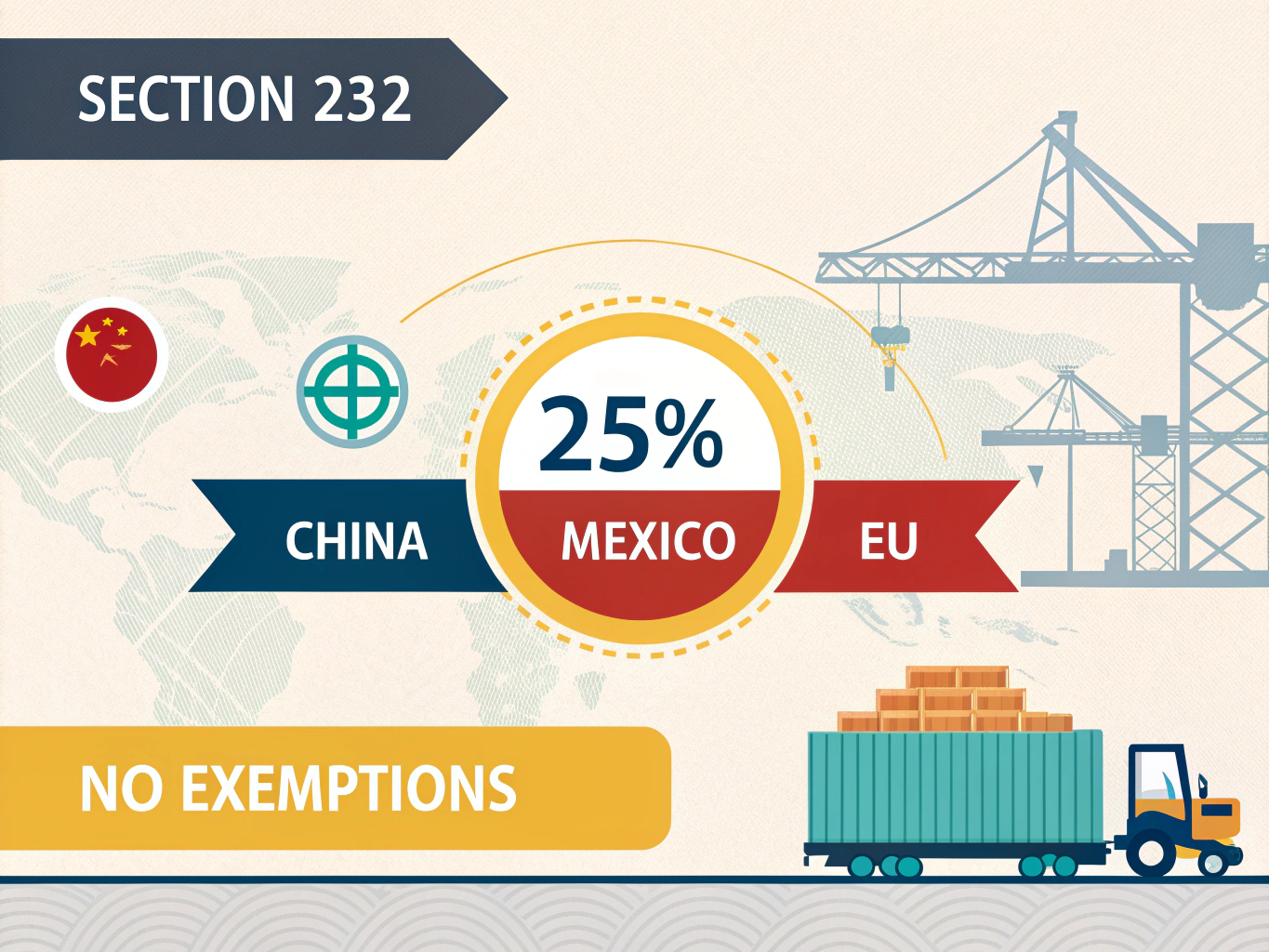
When I first started working in the import-export industry, I quickly learned that understanding tariffs was crucial for running a successful business. My company had to deal with various steel parts from overseas, and the 25% import tariff under Section 232 of the Trade Expansion Act of 1962 was something that impacted every transaction. At first, I was overwhelmed by the complexities of tariff classifications, the exemptions, and how they could affect pricing. However, over time, I realized that gaining a clear understanding of these tariffs, especially for custom steel parts, could make a significant difference in managing costs and ensuring smooth operations.
As of March 12, 2025, the U.S. imposes a 25% import tariff on all steel products, including custom steel parts, under Section 232 of the Trade Expansion Act of 1962. This tariff applies universally, with no exemptions, including imports from China, the European Union, Mexico, and other countries. In this article, we will explore the general tariff rate for custom steel parts, how the classification of these parts affects the tariff, any exemptions or special tariffs, and how you can determine the specific tariff rate for your parts.
What is the general tariff rate for Custom Steel Parts in the US?

The U.S. imposes a flat 25% import tariff on custom steel parts under Section 232 of the Trade Expansion Act of 1962. This tariff applies to all steel products, including custom steel parts, regardless of the country of origin. The purpose of the tariff is to protect U.S. steel manufacturers and national security interests by reducing reliance on foreign steel.
This tariff has a wide-reaching impact. It applies to imports from all countries, meaning even traditional steel-exporting countries like China, the European Union, and Mexico are not exempt. The 25% tariff can significantly increase the cost of steel parts, which can affect manufacturing prices, supply chains, and even customer pricing.
Dive deeper: The Impact of the 25% Section 232 Tariff
The Section 232 tariff has been one of the most significant changes in U.S. steel trade policy in recent years. Before its implementation, the U.S. largely relied on foreign steel at competitive prices. However, the introduction of this tariff was part of a broader strategy to boost domestic steel production and protect U.S. jobs.
Increased Cost for Businesses: For businesses importing custom steel parts, this 25% tariff represents a direct increase in costs. Companies must either absorb the cost increase or pass it onto customers, which can make their products more expensive compared to domestic alternatives.
Impact on Supply Chain: The tariff affects businesses that rely on steel imports to manufacture products, which can disrupt supply chains. It can be especially challenging for companies that have tight margins and depend on competitive pricing for their materials.
International Reactions: The imposition of these tariffs has not been without controversy. Countries like China and the EU have retaliated with their own tariffs on U.S. products, creating a ripple effect in global trade. The consequences of these retaliatory measures can increase costs and complicate the international trade environment.
| Tariff Type | Rate | Countries Affected | Application |
|---|---|---|---|
| Section 232 Tariff | 25% | All countries (No Exemptions) | Applies universally to all steel products |
How does the classification of Custom Steel Parts affect its import tariff?

The classification of custom steel parts determines which tariff rate applies to them. Steel products are classified under the Harmonized Tariff Schedule (HTS), which assigns specific codes to different types of goods based on their material composition and level of processing.
Some custom steel parts might be classified under different categories depending on their complexity and how they are made. For instance, basic steel products are classified under Chapter 73 of the HTS, but derivative products or specialized parts might have a different classification. If a steel product is classified as a derivative product, it can still be subject to the same 25% tariff under HTS 9903.81.91 based on its steel content.
Dive deeper: Tariff Classification and Steel Derivatives
The Harmonized Tariff Schedule (HTS) is a complex system that breaks down products into categories. For custom steel parts, it’s critical to get the classification right. Steel that is used to make custom parts is often processed to meet specific design needs, which can affect the tariff rate applied.
Derivative Steel Products: These are parts that have been processed beyond basic steel, like steel that has been welded, cut, or shaped into parts. While these products may still be subject to the 25% tariff, it depends on how they are classified under the HTS.
Melted and Poured Steel: Some steel parts made from U.S.-origin steel that is "melted and poured" in the U.S. may qualify for a 0% tariff. However, this is only applicable if the steel meets the specific "melted and poured" origin criteria, which means the steel must be produced in the U.S. before it can be further processed elsewhere. This is an example of how classification can affect tariff rates.
Correctly classifying your custom steel parts can help reduce the tariff rate and avoid costly errors. To navigate these complexities, it’s often best to consult with a customs broker or trade compliance expert.
| Product Type | HTS Code | Tariff Rate | Notes |
|---|---|---|---|
| Steel Products (Basic) | Chapter 73 | 25% | Standard tariff under Section 232 |
| Steel Derivative Products | HTS 9903.81.91 | 25% (or less) | Subject to classification and content |
| "Melted and Poured" Steel | Specific criteria | 0% | Must meet specific origin requirements |
Are there any exemptions or special tariffs for Custom Steel Parts in the US?

Currently, there are no exemptions for custom steel parts from the 25% Section 232 tariff. The U.S. previously allowed companies to apply for exclusions from the tariff, but the exclusion process was terminated, meaning that no new exemptions can be granted.
This means that companies importing custom steel parts from any country, including those with trade agreements like the U.S.-Mexico-Canada Agreement (USMCA), must still pay the 25% tariff. There are no special exceptions for specific industries or trade partners. However, steel products processed in the U.S. from steel that was "melted and poured" in the U.S. may qualify for a 0% duty under specific circumstances.
Dive deeper: Understanding Exemptions and the End of the Exclusion Process
The end of the exclusion process has significantly impacted businesses that had previously been able to request tariff relief. Many companies are now facing the full brunt of the 25% tariff, which raises the cost of their imports.
No Exemptions: Regardless of the country of origin or the nature of the steel parts, all custom steel imports are subject to the 25% tariff. This creates a level of unpredictability for businesses that relied on obtaining exemptions in the past.
Melted and Poured Steel: As mentioned earlier, if the steel used in custom parts is "melted and poured" in the U.S., it might qualify for a lower tariff or no tariff at all. This requires proof of origin and meets specific processing requirements.
Industry Impact: Industries that rely heavily on imported steel, such as automotive manufacturing, construction, and heavy equipment, have been especially affected by these tariffs. The lack of exemptions means they must adjust their pricing structures to account for the increased cost of materials.
| Exemption Type | Available | Notes |
|---|---|---|
| Section 232 Exemption | No | No new exclusions can be applied |
| "Melted and Poured" Steel | Yes (specific) | Must meet origin criteria for 0% duty |
How can I determine the specific import tariff for my Custom Steel Parts?

To determine the specific import tariff for your custom steel parts, you must correctly classify them under the Harmonized Tariff Schedule (HTS). The HTS assigns codes to various types of steel products, and these codes determine the tariff rate that applies to your goods.
Once you know the HTS code for your product, you can look up the corresponding tariff rate. In addition, you must also verify if your steel parts meet any specific criteria, such as the "melted and poured" rule, to potentially qualify for a lower tariff.
Steps for Determining the Tariff
The process of determining the correct import tariff is straightforward, but it can be complex. Here are the steps you should follow:
- Find the HTS Code: Use the Harmonized Tariff Schedule to find the correct classification for your custom steel parts. This code is critical for determining the applicable tariff.
- Check for Special Criteria: See if your custom steel parts meet any special origin requirements, such as being made from steel that was "melted and poured" in the U.S. If so, your parts may qualify for a 0% tariff.
- Consult with Experts: If you’re unsure about the correct classification or tariff rate, it’s always a good idea to consult with a customs broker or trade compliance expert.
| Step | Action |
|---|---|
| Step 1: Identify HTS Code | Use the HTS to find the code for your parts |
| Step 2: Check for Special Criteria | Determine if your steel qualifies for any exemptions |
| Step 3: Consult Experts | Work with a customs broker to confirm classification |
Conclusion
Understanding the import tariff for custom steel parts is critical for businesses sourcing steel globally. With the current 25% Section 232 tariff, companies need to correctly classify their steel parts, check for exemptions or special tariffs, and ensure compliance with U.S. trade policies. By staying informed about classification rules and consulting with trade compliance experts, businesses can minimize costs and avoid penalties.

